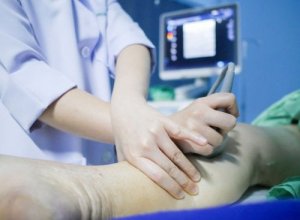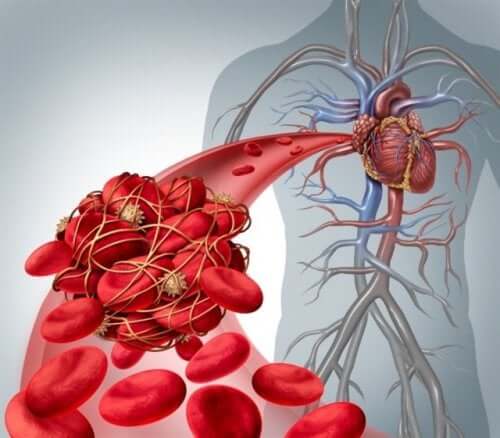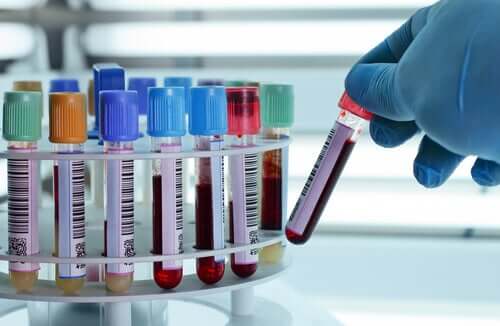Deep Vein Thrombosis: How to Detect and Prevent It

Deep vein thrombosis (DVT), or deep phlebothrombosis, occurs when a blood clot, called a thrombus, forms in one or more deep veins in the body. They usually affect the legs, although they can appear in other areas of the body.
This condition can occur if you have certain blood conditions that affect the way it coagulates. You can also develop if you don’t move for long periods. For instance, it may occur after surgery or an accident.
Deep vein thrombosis is a serious disorder. The blood clots that form in the veins can move through the bloodstream and get to the lungs. Once there, they can interrupt the blood flow. Similarly, clots can migrate to your heart. A heart attack can even occur in these situations.
What triggers deep vein thrombosis?

When someone has deep vein thrombosis, the veins farthest from their heart, the ones in the legs, have difficulty moving the blood. So, it accumulates there, producing edema and swelling.
The blood that goes from the heart to the feet circulates through the arteries. Then, it returns to the heart. It’s there from where it moves to the lungs to oxygenate.
When blood coagulates inside a vein, it can’t return to the heart. This is when it accumulates in the legs. Therefore, it swells and causes pain. Then, the blood coagulates and prevents normal circulation.
Blood clots of deep vein thrombosis can occur as a result of any phenomenon that prevents blood from circulating properly or that promotes clotting. For example, they may occur after surgery or as a side effect of certain medications and limited movement.
In any case, several risk factors make someone more susceptible to this condition. Among them we can find:
- Genetics: Some people inherit a disorder that leads to circulation problems.
- Prolonged rest: This may be hospitalization, for example.
- Injuries or surgery, as we mentioned above.
- Pregnancy, overweight or obesity.
- Smoking, among other factors.
Read also: Six Natural Treatments to Help with Blood Clot Problems
How’s deep vein thrombosis detected?

First, it’s important to note that there are other conditions with signs and symptoms that are similar to those of deep vein thrombosis. For example, pulmonary embolism, muscle injuries, cellulite and inflammation of the veins that are just under the skin. That’s why it’s important to do special testing to be able to locate the clots in the veins to differentiate this disease from others.
These are the tests.
Duplex Ultrasound
This is a test that uses sound waves to generate images to observe the flow of blood through the veins. It can detect blockages or blood clots in deeper veins. Thus, it’s the standard imaging test for the diagnosis of deep vein thrombosis.
D-Dimer Test
This test consists of a blood test that measures a substance that’s released into the blood when a clot breaks down. A negative result means that it’s a person isn’t likely to have this disease and vice versa.
Phlebography
This is the most accurate test to diagnose blood clots. However, it’s an invasive procedure, which means it requires doctors to use instruments to manipulate the body. It’s a special type of x-ray in which the doctor injects contrasting dye material into a large vein of the foot or ankle. This way they can see the deep veins of this limb.
MRI and CT Scan
Two tests offer images and help doctors diagnose and treat various conditions. The images show veins and any clots there may be. However, these aren’t used much for the diagnosis of this disease. Still, it’s an accessible resource, if necessary.
You may be interested: Nine Foods that May Help Reduce Your Risk of Thrombosis and Stroke
Prevention of deep vein thrombosis

The prevention of DVT is based on improving the blood flow that returns to the heart. So, it’s important to consult your doctor as they can recommend an exercise routine.
It’s also advisable to put your legs up regularly to facilitate circulation. In this regard, a person with this condition will be more comfortable if they raise the part of the mattress where the legs rest. It’ll help them sleep in a slightly elevated position.
If you’re a smoker, then try to quit. Tobacco is a risk factor for numerous heart conditions. Doctors also recommend exercising at least 3 days a week for at least 30 minutes each day. It also may be helpful to eat more foods that prevent clotting.
If necessary, the doctor may prescribe the use of anticoagulant drugs to prevent this kind of problem.
All cited sources were thoroughly reviewed by our team to ensure their quality, reliability, currency, and validity. The bibliography of this article was considered reliable and of academic or scientific accuracy.
- Piccinato, C. E., Cherri, J., & Moriya, T. (1995). Trombose venosa profunda. In Medicina.
- Weinmann, E. E., & Salzman, E. W. (1996). Trombosis venosa profunda. Revista Cubana de Medicina. https://doi.org/10.1016/S1636-5410(17)87867-3
- Rodriguez Moral, N. E. (1972). TROMBOSIS VENOSA. Revista Cubana de Cirugia.
This text is provided for informational purposes only and does not replace consultation with a professional. If in doubt, consult your specialist.








